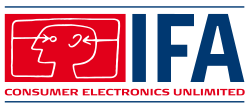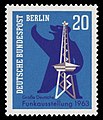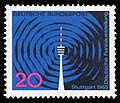International radio exhibition
| International radio exhibition | |
|---|---|

|
|
| Branch | Mobile communications fair |
| Place of issue | exhibition center Berlin |
| First exhibition | 1924 |
| Website | www.ifa-berlin.de |
| Last exhibition | |
| date | Aug 31, 2019 to Sep 5 2019 |
| Visitors | 245,000 |
| Exhibitors | 1,814 |
| Next exhibition | |
| date | 3rd Sep 2020 to Sep 5 2020 |
The international radio exhibition ( IFA ), since 2005 only IFA , in Berlin is one of the oldest industrial fairs in Germany, which takes place annually in the summer in the exhibition halls under the Berlin radio tower . It offers exhibitors the opportunity to present their products and developments in the entertainment and, in some cases, consumer electronics sectors to a wide audience . In the course of its history, numerous world novelties have started their way at the radio exhibition.
IFA target groups
The IFA, with the subheading “Consumer Electronics Unlimited”, is aimed primarily at consumer electronics retailers, the public and the media. For this group, IFA is the world's largest trade fair with more than 100,000 trade visitors in 2007 . In particular, it is aimed at European dealers and buyers - almost everyone is represented in Berlin. In addition, the IFA remains a "public event" that offers interested consumers a lot of information and entertainment on everything to do with electronic media.
history
The exhibition, first held in Berlin in 1924, took place annually until 1939. After the Second World War , they existed every two years from 1950 to 2005 with a few exceptions. Since then it has been an annual event again.
1920s
The IFA was founded as the Great German Radio Exhibition and was held for the first time on December 4, 1924 in the radio industry house built for this purpose on Messedamm on the site of what is now Hall 14 of the exhibition grounds in Berlin-Westend . At that time, 268 exhibitors mainly showed tube receivers , detectors and headphones . In 1924 more than 170,000 visitors saw the rather sober presentation without glitz and glamor. On September 3, 1926, the Berlin radio tower , one of the city's landmarks, was handed over to its destination on the occasion of the radio exhibition. In the same year, the first live reporting took place, initially via radio. In 1928 one of the first television broadcasts took place worldwide. The television pictures were 30 lines with 900 pixels and measured about 32 mm in diameter .
Presentation of Telefunken at the radio exhibition, 1928
1930s
At the opening in 1930, the physicist and Nobel Prize winner Albert Einstein spoke a greeting on the broadcasters of the Reichs-Rundfunk-Gesellschaft . The Ideal-Werke presented at the IFA 1932, the first German car radio before. At the 10th radio exhibition in 1933, the “ Volksempfänger ” (type VE 301) came onto the market as a tube receiver that was affordable for everyone . Of the total of around 700,000 devices sold, 100,000 are said to have been sold at the exhibition alone. In 1935, AEG presented the first tape recorder Magnetophon K1 . On August 19, 1935, the wooden house of the radio industry burned down at the foot of the Berlin radio tower; The fire destroyed exhibits and broadcast facilities such as the TV station "Paul Nipkow" installed there . The radio tower restaurant also burned out. At the 16th Great German Radio and Television Exhibition in 1939, the German radio industry presented the jointly developed “Volksfernseher” ( standard television receiver E 1 ). In addition, the first color television images were presented on another device.
There were no radio exhibitions from 1940 to 1949 during the war and after the war.
The VE 301 people's receiver presented during the radio exhibition in 1933
Joseph Goebbels with a VE 301 DYN people's receiver at the 1938 radio exhibition
The standard television receiver E 1 (device from Telefunken ) presented at the radio exhibition in 1939
Changing venues (1950–1970)
Another radio exhibition took place in 1950: this time the venue was not Berlin - at that time already divided - but Düsseldorf . The German radio exhibition in Düsseldorf was the 17th radio exhibition. Among other things, the first VHF receivers were presented at this trade fair .
The next radio exhibition took place again in Düsseldorf in 1953, and a biennial cycle was introduced. The attractions of this trade fair included television sets with a picture tube of up to 43 cm. In 1955 the radio exhibition was held again in Düsseldorf and in 1957 (20th) and 1959 for the first time in Frankfurt am Main ; In 1961 it took place in Berlin for the first time after the end of the war.
On August 25, 1967, at the push of a button, Willy Brandt officially opened the Federal German color television, which works according to the PAL system , at the 25th Great German Radio Exhibition in Berlin . The color image started due to an error before Willy Brandt pressed the button.
An exhibition took place in Stuttgart for the last time (after 1965) in 1969; it was called the Deutsche Funkausstellung again, so it did not include the addition of "Big One". In 1970 the last trade fair was held in Düsseldorf with a one-off interruption of the two-year cycle, which also ended the change of event location. From 1971 the fair was again held permanently in Berlin as the 28th “International Radio Exhibition” (IFA). International meant that all foreign exhibitors were admitted, before they had to have a production facility in Germany.
The festival hall of Messe Frankfurt during the radio exhibition, 1959
Postage stamp from the Deutsche Bundespost Berlin (1961) for the radio exhibition
Postage stamp from the Deutsche Bundespost Berlin (1963) for the radio exhibition
Postage stamp of the German Federal Post Office (1965) for the radio exhibition
Postage stamp from the Deutsche Bundespost Berlin (1967) for the radio exhibition
1970s
Since 1971 the radio exhibition has been held in Berlin as the "International Radio Exhibition" (IFA) every two years. In 1971, the first home video recorders in the VCR system and the first wireless remote controls were shown. In another first, there was in 1973, when with the RIAS / BR / WDR production Demolition ( The demolished one ) on the novel by Alfred Bester first radio play in artificial head - Stereofonie was presented. 1977 were first Teletext broadcasts and on-screen text (BTX) presented. New storage media were also shown to interested trade visitors: for example, the Video 2000 system was presented at the radio exhibition.
The Telefunken TP 1005 video recorder presented at IFA 1973
1980s
On September 5, 1981, the 33rd IFA ran the first two-tone and stereo broadcast on television. The newly developed compact disc was presented for the first time.
In 1983 TV receivers with digital signal processing were presented for the first time. 3-D television was also shown for the first time as an experiment.
The first HDTV demonstrations took place in 1985 . In 1985, multi-standard television sets, the video programming system (VPS) and satellite tuners were presented.
In 1987 DAT recorders , CD video sets, jumbo televisions, D2-MAC demonstrations, the radio data system (RDS) and the MOD recorder were among the attractions.
1989: European HDTV standard, SVHS / Hi8 camcorders, around 400,000 visitors
1991 to 2005
An all-German IFA has been taking place again since 1991. Innovations in these years included:
- 1991 with 515,752 visitors: digital compact cassette (DCC) , MiniDisc , re-recordable CD, photo CD and CD-Interactive
- 1993 with 449,804 visitors: laser televisions, video programming standards “Show View” and “Voice Commander” and car radios as a media center
- 1995 with 499,437 visitors: 16: 9 / PALplus, TV / PC combinations, Dolby Surround systems, flat screens and laser TV
- 1997 with 436,076 visitors: digital TV sets, TV video telephones , DAB receivers, DVD players, digital camcorders and digital cameras
- 1999 with 376,552 visitors: plasma flat screens, MP3 players, cell phones with Internet access and home networks
- 2001 with 369,211 visitors: DVB-T, Multimedia Home Platform (MHP), DVD recorder, 29-inch LCD TV in widescreen format, TV set with Internet access, DVD + RW PC burner and mobile phones with GPRS and Bluetooth
- 2003 with 273,800 visitors: LCD , plasma and projection TV sets, camcorders and digital cameras, Multimedia Home Platform (MHP), hard drive video recorders, digital radio and DVB-T
- 2005 with 245,849 visitors: HDTV sets, SE displays, e-paper , networked household electronics , mobile phone TV. In addition, all public radio stations were switched to the Astra 19.2 ° E satellite (radio transponder)
State Secretary Sabine Bergmann-Pohl at the stand of the Federal Press Office at IFA 1991
Live broadcast of the ARD morning magazine from IFA 2005
Annual event since 2005
With the decision to hold a trade fair again in 2006, the two-year cycle actually changed to an annual cycle from 2005. The 46th IFA Berlin 2006 was opened by Chancellor Angela Merkel and increasingly dominated with products from the entertainment and telecommunications sectors (new mobile phones from LG). Innovations in 2007 with 225,050 visitors included Blu-ray Disc and HD DVD , the two storage media for high-resolution video files that were competing for the successor to DVD at the time. Even HDTV devices with integrated hard drive and flat panel displays with up to 2.62 meters diagonal were presented. Mobile navigation devices were also presented. In 2008 household and kitchen appliances were approved for the exhibition for the first time. The largest flat screen shown had a diagonal of 3.81 meters. For the first time, Sony presented a flat screen with Edge LED backlight . A comprehensive range of large full HD televisions was presented in 2009 as a preview of the 2010 soccer World Cup . The IFA Artist Prize premiered in 2009 and was first awarded on September 5th. A number of new 3DTV devices were introduced in 2010 after the first home 3D technology was introduced in the spring. To mark the opening of IFA 2010 on September 3, Deutsche Telekom offered a 3D press conference for the first time. The prerequisite for receiving the press conference was a connection speed of at least 25 megabits per second and a 3D-capable television with the appropriate glasses.
The 50th edition of IFA in 2010 had 235,000 visitors, including 125,000 trade visitors, and 1,423 exhibitors on 134,400 square meters of exhibition space. At the same time, the iZone theme world was created around the product world of Apple ( iPod , iPhone and iPad ) and Android as well as the associated apps . In 2011 around 238,000 and in the years 2012 to 2014 around 240,000 visitors were recorded.
Presentation of a mobile phone from LG Electronics at IFA 2006
“ Stasi 2.0 ” demonstration at IFA 2007
Live broadcast by the TV station n-tv from IFA 2014
See also
Web links
- International radio exhibition Berlin of Messe Berlin
- Exact periods of all radio exhibitions on welt-der-alten-radios.de, accessed on October 28, 2014
- Fair report on IFA 2009
- IFA 2010 preview from messelive.tv: Interview with IFA director Jens Heithecker and gfu press spokesman Roland M. Stehle
- Audio podcast “50 Years of IFA” from the online magazine inside-handy.de
- Trade fair journal and topics IFA 2010
- Worldwide TV program from IFA 2011 in three languages via internet, cable and satellite
Individual evidence
- ↑ The Chronicle of the Radio Exhibition (March 23, 2017) - IFA Berlin, August 31 to September 5, 2018. Retrieved on April 17, 2018 .
- ↑ Too embarrassing to ask: What does "IFA" actually stand for? In: CHIP Online. Retrieved April 17, 2018 .
- ^ History of the IFA ( Memento from July 31, 2015 in the Internet Archive )
- ↑ PresseBox (c) 2002-2020: Premiere in Berlin: IFA artist award with 8 artists every 8 minutes, IFA artist award - c / o FQL - agency for communication management, press release - PresseBox. August 8, 2009, accessed on May 7, 2020 (German).
- ↑ New: the artist award at IFA. In: tip berlin. August 31, 2009, accessed on May 7, 2020 (German).
- ↑ Directed by Marc Schütrumpf
- ^ The IFA ( Memento from September 20, 2010 in the Internet Archive )
- ↑ IFA iZone - New exhibition area around the product world of Mac, iTech and apps ( Memento from September 25, 2010 in the Internet Archive )
- ↑ Trade fair with more visitors - ARD draws a positive balance . Article dated September 11, 2013, accessed July 16, 2014.
- ↑ heise.de - IFA gives the battered industry new impetus . Article dated September 11, 2013, accessed July 16, 2014.
- ↑ The IFA balance sheet 2014: constant visitor numbers, higher order volume . Article dated September 11, 2014, accessed September 23, 2014.































